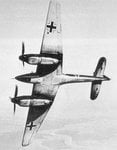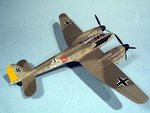Navigation
Install the app
How to install the app on iOS
Follow along with the video below to see how to install our site as a web app on your home screen.
Note: This feature may not be available in some browsers.
More options
You are using an out of date browser. It may not display this or other websites correctly.
You should upgrade or use an alternative browser.
You should upgrade or use an alternative browser.
FW 187
- Thread starter Smokey
- Start date
Ad: This forum contains affiliate links to products on Amazon and eBay. More information in Terms and rules
More options
Who Replied?the lancaster kicks ass
Major General
- 19,937
- Dec 20, 2003
i assume you mean mostly for the BoB, well i don't think it'd make that much difference as the Bf-110 proved the concept wasn't very successful as the RAF found anything over Britain with more than one engine easy prey...........
DIOGENIS
Airman
It was a very promising aircraft.Excellent performance, (speed / climb) if used the correct way, it could fill the gaps of the Me 109.
the lancaster kicks ass
Major General
- 19,937
- Dec 20, 2003
you mean the same way the Bf-110 was supposed to?
Tony Williams
Airman 1st Class
I had the Luftwaffe adopt it instead of the Bf 110 in my alternate WW2 history novel, The Foresight War 8)
It could have been a very capable long-range fighter, as it was much faster and more agile than the 110.
Tony Williams: Military gun and ammunition website and discussion forum
It could have been a very capable long-range fighter, as it was much faster and more agile than the 110.
Tony Williams: Military gun and ammunition website and discussion forum
DIOGENIS
Airman
The BF 110 wasn't supposed to assist the bf 109, it was supposed to do it's job plus more (ground attack).Instead of high altitude missions , it did everything else with the known results.Apart from the superior performance, fw 187 could bring the best results by the use of better suited tactics.Thus, Hurricane should be no problem..the lancaster kicks *** said:you mean the same way the Bf-110 was supposed to?
Lanc I dont think you give the Fw-187 any credit. The 187 was a much better aircraft than the Bf-110 and would have performed much better than it. We will never know since it never showed up for the BoB but I would not just throw it out like the Bf-110.
The Fw-187 had no major technical problems and was only doomed because of political reasons. She was a very maneuverable aircraft and flight tests have shown that she could tangle with a Spitfire at the time of the BoB and her performance was excellent.
She outperformed the Bf-110 in every role that was desired.
Might I add she was a beautiful aircraft as well.
The Fw-187 had no major technical problems and was only doomed because of political reasons. She was a very maneuverable aircraft and flight tests have shown that she could tangle with a Spitfire at the time of the BoB and her performance was excellent.
She outperformed the Bf-110 in every role that was desired.
Might I add she was a beautiful aircraft as well.
Attachments
- Thread starter
- #8
We can consider ourselves lucky. Had the Germans hadn't been so near-sighted, they would have produced a magnificent twin-engined aircraft that would have given a great many headaches to the allied pilots.
There never was any official requirement for the Fw 187, and as such it was developed with the hopes of signing a contract for a working plane instead of a sheet of paper. From the start, the 187 was meant to be fast. Kurt Tank and his team made every attempt do minimize drag, and this included the use of surface-evaporation cooling for the engine. Later troubles with the system forced them to resort to normal radiators. The fighter was supposed to be powered by DB 600 engines of 960 HP, but they weren't available, so the team opted for Jumo 210 of 610HP. At first, the armament consisted of only two MG 17s, but it was to be augmented at a later date.
The first three prototypes were completed as single seaters, with a neat Fw 190-like canopy. Their main problem lay with the undercarriage which was week and prone to collapse. Comparing the V1's specs with those of the Westland Whirlwind Mk I, it appears that the German fighter was a better performer, albeit slower. The first prototype crashed, claiming the life of Paul Bauer.
The design was modified to make it a Zerstörer, or heavy fighter. A second crew member was added to serve as a radio/navigator, but the sleek bubble canopy was replaced by a framed job. The new version was allocated the Fw 187A-0 designation and a small series was built. They were subsequently used as factory defence fighters. The A version was superior in every respect to the Bf 110, save for the armament. A few of them were also sent to Denmark where operational pilots flew them. On one occasion, a Spitfire was shot down.
The V7 prototype was fitted with DB 601 engines and further versions were planned, including the C version, which would have used DB 605s and would have packed a mighty wallop. Fortunately, it never went beyond the drawing board.
MPM 1/48 FW-187 'Falke', by Olivier Lacombe
There was alos the Heinkel He 100:
Heinkel He 100 archive file
Thank goodness that Goering seemed to be more interested in a deal with Messerschmitt than the performance of the aircraft he bought.
Attachments
Twitch
Staff Sergeant
Here's a link to another discussion we had about this baby. http://www.ww2aircraft.net/forum/av...ocke-wulf-fw-187-a-4015.html?highlight=fw+187
It would have been really interesting to see how this would have turned. She is a beautiful aircraft and aparantly performed very well and was pretty agile. A good what if, should have, could have, good think it did not...
Users who are viewing this thread
Total: 1 (members: 0, guests: 1)






